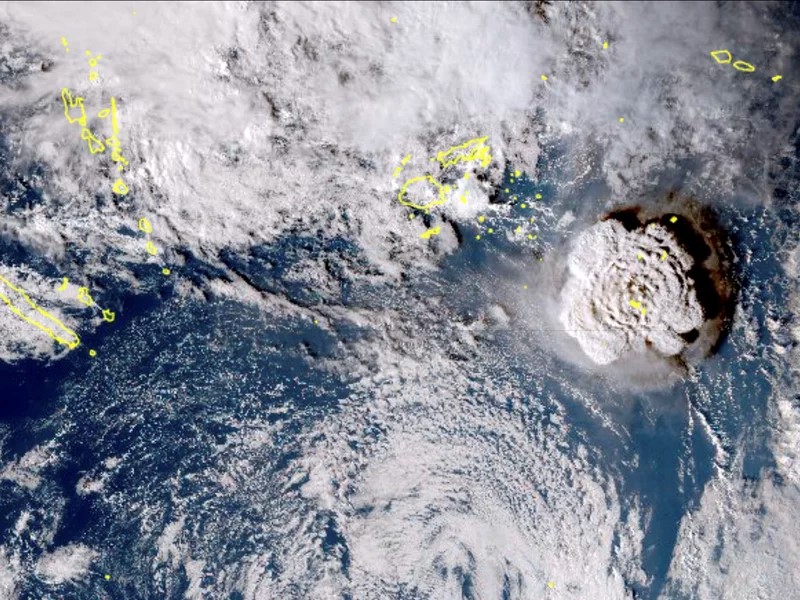Pauta spoke Tongan at home as a child, and was raised on the island until she was 6 years old. She said the volcanic eruption and subsequent tsunami struck fear in her.
“When you hear ‘tsunami,’ it’s very scary because Tonga is an island and it’s pretty flat,” she said, meaning there are few places to flee for higher ground.
There is some hope. People from New Zealand, Australia and elsewhere have pledged support, which Pauta said may be an avenue to get updates about specific people on the island of Tonga. And there haven’t been any reports of deaths from the island yet, another light in the gloom.
“I believe they’re safe,” she said. Still, things seem dire for those trying to recover their lives. “There is a thick coat of ash on the ground and just widespread damage of buildings.”
Dave Snider, the tsunami warning coordinator for the National Tsunami Warning Center in Palmer, Alaska, said it was very unusual for a volcanic eruption to affect an entire ocean basin, and the spectacle was both “humbling and scary.”
The tsunami waves caused damage to boats as far away as New Zealand and Santa Cruz, California, but did not appear to cause any widespread damage. Snider said he anticipated the tsunami situation in the U.S. and elsewhere to continue improving.
Tsunami advisories were earlier issued for Japan, Hawaii, Alaska and the U.S. Pacific coast. The U.S. Geological Survey estimated the eruption caused the equivalent of a magnitude 5.8 earthquake. Scientists said tsunamis generated by volcanoes rather than earthquakes are relatively rare.
According to an NWS update as of 3:15 p.m. ET, the highest surge was recorded in Port San Luis, Calif., where the water reached more than 4 feet over normal levels. Authorities had prepared early Saturday for the possibility of a small yet potentially disruptive surge. Beaches were cleared from San Diego to San Francisco. More than 100 people were evacuated from the boats, docks and shoreline of the Berkeley Marina.
The tsunami advisory in the San Francisco Bay Area was lifted Saturday night, though Santa Cruz and other areas along the California coast were still under advisory.
The Tonga Meteorological Service said a tsunami warning was declared for all of the archipelago, and data from the Pacific tsunami center said waves of 2.7 feet were detected.
Rachel Afeaki-Taumoepeau, who chairs the New Zealand Tonga Business Council, said she hoped the relatively low level of the tsunami waves would have allowed most people to get to safety, although she worried about those living on islands closest to the volcano. She said she hadn’t yet been able to contact her friends and family in Tonga.
Tonga gets its internet via an undersea cable from Suva, Fiji. All internet connectivity with Tonga was lost at about 6:40 p.m. local time, said Doug Madory, director of internet analysis for the network intelligence firm Kentik.
Some Bay Area Tongans were able to get hold of family just before the island went dark. Sosefo Penitani of Tracy works as secretary for the U.S. Tongan Catholic Chaplaincy and grew up in Tonga — he came to the Bay Area when he was 18, in 1986. He has 13 siblings and counts brothers, sisters and other family in Tonga.
“We believe in large families,” he said.
Penitani told KQED he was able to talk to three of his siblings still living in the islands just before cellphone and internet service was completely disrupted.
“The good thing when we talked to them, the waves was coming is not a high-rise wave — they were talking about 3-, 4-foot instead of 10- or 20-foot waves there,” Penitani said. “So that’s the luckiest part of that.”
Penitani said that, at first, his family didn’t take the possibility of a tsunami seriously. But they feel differently now. Penitani said he believes his family made it to some higher elevation on one side of the island. But he’s heard of homes in Tonga flooding. Already, reports from neighboring New Zealand have said there is much structural damage on the island.
“The lucky thing is nobody was [dead] from this” so far, he said. “That’s the main thing that brings us relief.”
But, he said, he fears future tsunamis there, as scientists work to determine whether the Hunga Tonga-Hunga Ha’apai volcano will erupt again soon. The devastation that could bring, even just in damage to homes, if not lives, worries him.
“We ask,” he said, “for people to include our Tongan people with their prayers.”
KQED’s Joe Fitzgerald Rodriguez and Sara Hossaini, Nick Perry of The Associated Press, and Becky Sullivan of NPR contributed to this report.

